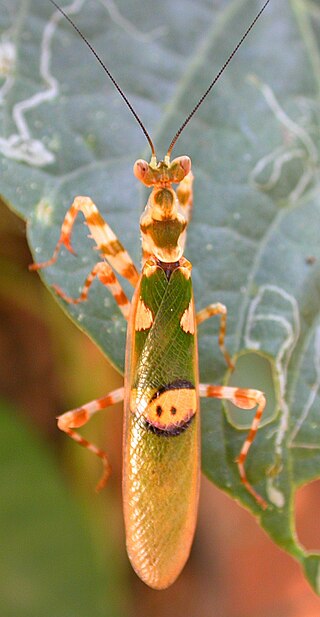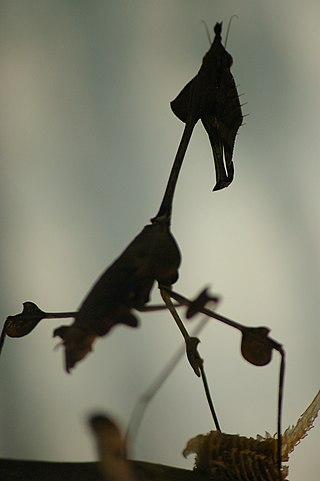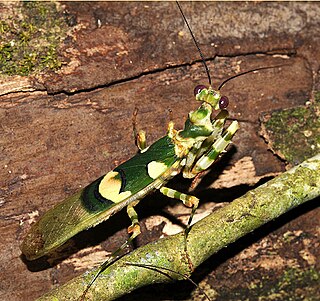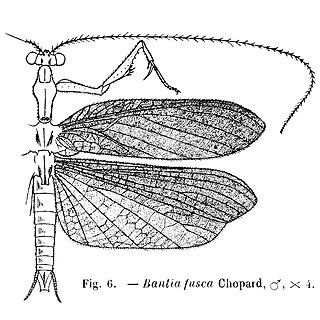
Mantidae is one of the largest families in the order of praying mantises, based on the type species Mantis religiosa; however, most genera are tropical or subtropical. Historically, this was the only family in the order, and many references still use the term "mantid" to refer to any mantis. Technically, however, "mantid" refers only to members of the family Mantidae, and not the 14 remaining families of mantises. Some of the most recent classifications have promoted a number of the mantid subfamilies to the rank of family, e.g. Iridopterygidae, Sibyllidae, Tarachodidae, Thespidae, and Toxoderidae, while other classifications have reduced the number of subfamilies without elevating them to higher rank.

Empusidae is a family of plant-mimicking mantises, consisting of 10 genera, in two subfamilies. Unlike many other mantis families, the Empusidae are a monophyletic lineage. Empusidae mantises are ambush predators, with mouthparts adapted to feeding on other insects and small animals. The majority of Empusidae species are distributed throughout Africa, but they are also found in Southeast Asia and in the southern parts of Europe.

Hymenopodidae is a family of the order Mantodea (mantises), which contains six subfamilies. Some of the species in this family mimic flowers and are found camouflaged among them; these are called flower mantises. Their coloration is aggressive mimicry, luring prey to approach close enough to be seized and eaten.
Idolomorpha is a genus of mantises in the family Empusidae.

Hymenopodinae is a subfamily of the mantis family Hymenopodidae that includes several species of flower mantises.

Creobroter is a genus of flower mantises in the tribe Hymenopodini; species are concentrated in Asia. The name comes from the Greek kreo-, meaning "flesh") and broter" meaning "eating", therefore, "flesh-eating", an apt name for a predatory insect. Both sexes have long wings and are capable fliers. Full-grown males are about 3 to 4 cm in length; females are about 4 to 5 cm.

Flower mantises are praying mantises that use a special form of camouflage referred to as aggressive mimicry, which they not only use to attract prey, but avoid predators as well. These insects have specific colorations and behaviors that mimic flowers in their surrounding habitats.

Gongylus is a genus of praying mantises in the family Empusidae. Characterized by extremely slender limbs with large appendages, at least one species is kept as a pet by hobbyists. Males of the species are capable of flight.

Idolomantis is a monotypic genus of praying mantises in the family Empusidae. It contains the single species, Idolomantis diabolica, commonly known as the devil's flower mantis or giant devil's flower mantis. It is one of the largest species of praying mantises, and is possibly the largest that mimics flowers.

Rhombodera is a genus of praying mantises native to Asia and possessing common names such as shield mantis, hood mantis, and leaf mantis because of their extended, leaf-like thoraxes.
Blepharodes is a genus of North African mantis in the family Empusidae.

Chlidonoptera is an African genus of praying mantis in the family Hymenopodidae and tribe Hymenopodini.
Rhombodera papuana is a species of praying mantises in the family Mantidae. It is found on the island of New Guinea.

Empusa fasciata is a species of praying mantis in the genus Empusa in the order Mantodea.

Thespidae is a family of insects in the order Mantodea. Following a major revision of this order in 2019, the old-world subfamilies Haaniinae and Hoplocoryphinae, previously placed here, have been upgraded to family level. Many genera are Neotropical, but the Thespinae are represented in Africa, Asia, Europe, and North America.

Mantises are an order (Mantodea) of insects that contains over 2,400 species in about 460 genera in 33 families. The largest family is the Mantidae ("mantids"). Mantises are distributed worldwide in temperate and tropical habitats. They have triangular heads with bulging eyes supported on flexible necks. Their elongated bodies may or may not have wings, but all Mantodea have forelegs that are greatly enlarged and adapted for catching and gripping prey; their upright posture, while remaining stationary with forearms folded, has led to the common name praying mantis.

Helvia is a genus of praying mantises in the family Hymenopodidae found in Southeast Asia. It is monotypic, being represented by the single species, Helvia cardinalis.

Harpagomantis is a genus of praying mantises in the family Galinthiadidae found in Africa. It is monotypic, being represented by the single species Harpagomantis tricolor.
Thespinae is a subfamily of mantises in the family Thespidae. There are 16 genera and at least 40 described species: found in most continents.















